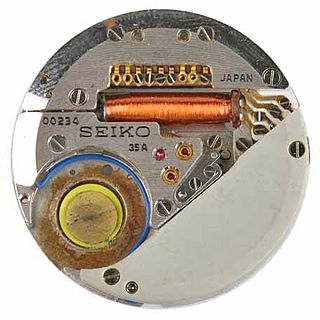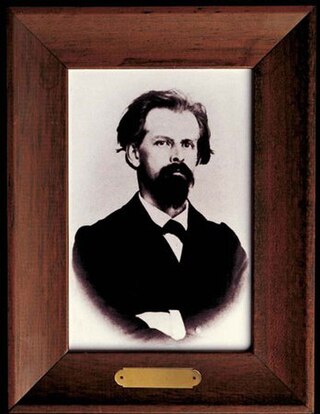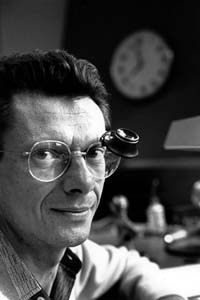
Vacheron Constantin SA is a Swiss luxury watch and clock manufacturer founded in 1755. Since 1996, it has been a subsidiary of the Swiss Richemont Group. Vacheron Constantin is one of the oldest watch manufacturers in the world with an uninterrupted watchmaking history since its foundation in 1755. It employs around 1,200 people worldwide as of 2018, most of whom are based in the company's manufacturing plants in the Canton of Geneva and Vallée de Joux in Switzerland.

In horology, a tourbillon is an addition to the mechanics of a watch escapement to increase accuracy. Conceived by the British watchmaker and inventor John Arnold, it was developed by his friend the Swiss-French watchmaker Abraham-Louis Breguet and patented by Breguet on 26 June 1801. In a tourbillon the escapement and balance wheel are mounted in a rotating cage, with the goal of eliminating errors of poise in the balance giving a uniform weight.

La Chaux-de-Fonds is a Swiss city in the canton of Neuchâtel. It is located in the Jura Mountains at an altitude of 992 metres, a few kilometres south of the French border. After Geneva, Lausanne, Bienne, and Fribourg, it is the fifth-largest city in the Romandie, the French-speaking part of the country, with a population of 36,915.

In horology, a complication is any feature of a timepiece beyond the display of hours, minutes and seconds. A timepiece indicating only hours, minutes and seconds is known as a simple movement. Common complications include date or day-of-the-week indicators, alarms, chronographs (stopwatches), and automatic winding mechanisms. Complications may be found in any clock, but they are most notable in mechanical watches where the small size makes them difficult to design and assemble. A typical date-display chronograph may have up to 250 parts, while a particularly complex watch may have a thousand or more parts. Watches with several complications are referred to as grandes complications.

Le Locle is a municipality in the Canton of Neuchâtel in Switzerland.
Ulysse NardinSA is a Swiss luxury watchmaking company founded in 1846 in Le Locle, Switzerland.
Girard-Perregaux SA is a luxury Swiss watch manufacture with its origins dating back to 1791. In 2022, then-owner French luxury group Kering sold its stake in Sowind Group SA, the parent company of Girard-Perregaux, via management buyout. Headquartered in La Chaux-de-Fonds, Switzerland, the company opened the Girard-Perregaux Museum near its headquarters in Villa Marguerite in 1999. It is best known for the historic Tourbillon with three gold bridges, which was awarded a gold medal at the 1889 International Exposition in Paris soon after the launch of the watch. Other notable models from the company include the collection 1966, Vintage 1945, and models such as Tri-Axial Tourbillon and Laureato, an icon inspired from the 1970s.

Le Petit-Fils de L.-U. Chopard & Cie S.A., commonly known as Chopard, is a Swiss manufacturer and retailer of luxury watches, jewellery and accessories. Founded in 1860 by Louis-Ulysse Chopard in Sonvilier, Switzerland, Chopard has been owned by the Scheufele family of Germany since 1963.

The Federation of the Swiss Watch Industry (FH) is the Swiss watch industry's leading trade association, headquartered in Bienne, Switzerland. The Federation is a private, professional and non-profit association.

The quartz crisis (Swiss) or quartz revolution was the advancement in the watchmaking industry caused by the advent of quartz watches in the 1970s and early 1980s, that largely replaced mechanical watches around the world. It caused a significant decline of the Swiss watchmaking industry, which chose to remain focused on traditional mechanical watches, while the majority of the world's watch production shifted to Japanese companies such as Seiko, Citizen and Casio which embraced the new electronic technology. The strategy employed by Swiss makers was to call this revolution a 'crisis' thereby downgrading the advancement from Japanese brands.
Universal Genève SA is a Swiss luxury watch company, founded in 1894 as Universal Watch. It is a subsidiary of Breitling SA. Since its beginnings, the company has produced complete watches with in-house movements. Along with neighboring Geneva companies Audemars Piguet, Girard-Perregaux, Patek Philippe and Rolex, Universal is internationally regarded for its style of craftsmanship as a manufacture d'horlogerie. Universal Genève is known for creating the first-ever chronograph in 1917.

Maîtres du Temps is a Swiss watch company. Founded in 2005 by Steven Holtzman, the brand is based in La Chaux-de-Fonds, Switzerland. The brand launched in Geneva in 2008 with Chapter One, a watch developed by Christophe Claret, Roger Dubuis and Peter Speake-Marin.
Léon Louis Gallet (1832–1899), watchmaker, entrepreneur, philanthropist, and past family patriarch of the Gallet Watch Company of Switzerland, is considered as one of the primary architects and founders of the 19th century industrialization of the Swiss watchmaking industry.

Gallet (ˈgæl.eɪ) is a historic Swiss manufacturer of high-end timepieces for professional, military, sports, racing, and aviation use. Gallet is the world's oldest clock making house with history dating back to Humbertus Gallet, a clock maker who became a citizen of Geneva in 1466. It is one of the oldest continuously operating companies in the World. The Gallet & Cie name was officially registered by Julien Gallet (1806–1849) in 1826, who moved the family business from Geneva to La Chaux-de-Fonds, Switzerland. Prior to this date, operations commenced under the name of each of the Gallet family patriarchs.
An observatory chronometer is a timepiece that has passed stringent testing and a slate of accuracy tests. Thus, the "observatory trial" developed as the standard process for determining accuracy of timepiece movements. If the chronometer passed the stringent testing, it would be certified.

Constant Girard was a Swiss watchmaker from the 19th century, who marked his time by his developments in the escapement systems, in particular that of the tourbillon. His most famous watch, the Tourbillon with three gold bridges, is still fabricated today in modern versions by the Swiss watch manufacturer, Girard-Perregaux.

Jean-François Bautte was a Swiss watchmaker and jeweller famous for several reasons: he founded the most complete watch manufacture of his time in Geneva. He also created watches and jewellery for famous people and was one of the inventors of the extra-thin watch.

Dominique Loiseau was a French and Swiss watchmaker who worked at the highest levels of complex horology from the mid 1970s onwards He was the creator of several notable timepieces, including six Montres de Sables, the Rose de Temps clock, the Renaissance or Capriccio pocket watches and the Blancpain 1735 wristwatch. In 2011 he presented, the Loiseau 1f4, one of the most complicated automatic watches with eight patents. Loiseau announced in 2012 a collaboration with Swiss watch manufacturer Girard-Perregaux.

François Perregaux was a Swiss watchmaker and businessman.